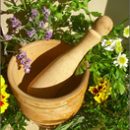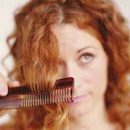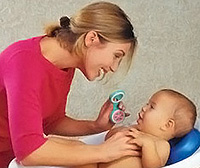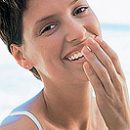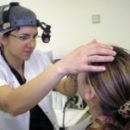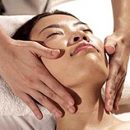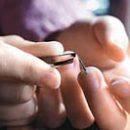It turns out erytraism, not everyone who sweats and getting the pathogen of this disease on the skin is not always enough to get sick. What factors favors the development of erytress and what principles of treatment are effective in the fight against this ailment - you will learn from the article.
Content
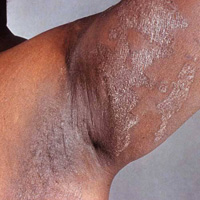 Erytrazz - this is a fungal skin disease related to the group of surface pseudomycosis. Mikoses are caused by vegetable microorganisms - mushrooms. Actually, mushrooms are widespread in nature, but pathogenins (that is, there are capable of causing a disease) for humans and animals only a small part of them.
Erytrazz - this is a fungal skin disease related to the group of surface pseudomycosis. Mikoses are caused by vegetable microorganisms - mushrooms. Actually, mushrooms are widespread in nature, but pathogenins (that is, there are capable of causing a disease) for humans and animals only a small part of them.B norm of human skin is populated with a huge number of bacteria and mushrooms, peacefully coexistent on its surface. Our skin has certain properties that protect it from infection by pathogens. These include a dense and dry burner, practically impenetrable for microorganisms, and adhesive intercellular substance - a complex mixture of lipids, tightly connecting cells and also protecting the skin. Other factors that stop the penetration of pathogenic microorganisms include constant updating of skin cells, acid pH, the presence of immunoglobulins in sweat and various types of skin flora.
Skin infections, and among them erytrazz, as a rule, develop only when injury, excessive hydration or inflammatory skin diseases break these protective properties. Skin infection organisms may be part of a permanent skin fluor or nearest mucous membranes or originate from external sources, such as another person, the environment or infected objects.
Erytrician infection is mainly due to a sick person or through various objects that used in patients, rarely, when you can get infected with this disease, picing the pathogen from the soil, going through barefoot.
In addition to the contact of CoryneBacterium Minutissum, and this is the erytasma causative agent, there are still favorable factors on the skin for the development of the disease, such as high sweating, sweat chemistry, human age, state of the domestic secretion glands, etc. Infectious and chronic diseases, reactivity of the body, changing sweat chemistry, skin condition, hair, also affect the occurrence of the disease. It is not for nothing that it is considered that erytraism is a disease of dirty and sweaty armpits. And she does not manifest any.
The manifestations of fungal lesions of the skin are very diverse: for example, erytramsman likes to be located in the folds - inhabricted-screaming, armpit, under the lactic glands in women. This skin lesion has a kind of clear rounded brownish or pinkish-brownish spots, slightly peeling. Since the disease practically does not bother patients, it remains unnoticed for many years. The unpleasant sensations on the affected areas of the skin may appear when infections are complicated by infections, with diallos or the exacerbation of the disease itself.
So - outer therapy of skin diseases. Outdoor therapy goals are:
- elimination of the immediate cause of the disease, as well as developing changes in the skin and related subjective sensations (if any);
- Protection of affected skin areas from external influences.
In the treatment of skin diseases in general and eritresses in particular, it should be borne in mind that each stage of the disease requires various drugs and, in particular, forms for outdoor use (for example, erytraism can leak without inflammatory process if it is not complicated and inflammation on the skin surface, if infection is joined to it).
Getting Started to the outer treatment of the disease, the first thing to do the doctor is to pre-clear the affected skin from the crust, the remains of the used ointments and T. NS. Doctors have a good rule: at first, for external treatment, therapeutic agents on a limited area and only with good tolerability to use them for the treatment of all the affected skin, as well as at the beginning of treatment, apply weak concentrations of drugs, gradually increasing their dose and moving to more actively acting Medications. This is a very correct approach, because the skin reaction to different medicines can be completely not even the same. No wonder because one of the basic principles of therapy of all skin diseases is a rule: the sharper process, the more tenderness should be therapy.
The next important stage of the appointment of external treatment is the choice of dosage form, which depends:
- on the nature of the skin changes - acute, subacute or chronic inflammation (stains under eritresses, as a rule, are chronic);
- from localization of the focus of lesion (erytraism «loves» body folds);
- from the prevalence of the pathological process.
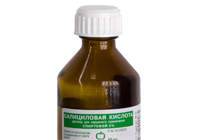 Drug forms used for the treatment of skin diseases include: solutions, rims, moisture-drying dressings, warming compresses, alcohol solutions, powder, shacking, paste, ointment, cream, plaster, varnish, glue and drugs (anti-inflammatory, resolving, keratolytic , anti-face, migratory, disinfecting, antiparasitic and fungicidal). Here are how many.
Drug forms used for the treatment of skin diseases include: solutions, rims, moisture-drying dressings, warming compresses, alcohol solutions, powder, shacking, paste, ointment, cream, plaster, varnish, glue and drugs (anti-inflammatory, resolving, keratolytic , anti-face, migratory, disinfecting, antiparasitic and fungicidal). Here are how many.
But for the treatment of eritresses, not all of the listed forms are used. Outdoor treatment of eritresses is to lubricate the affected skin sections with 2-3% iodsalicyl alcohol for 7-10 days; 5% erythromycin ointment or 2% erythromycin solution 2 times a day for 7 days; as well as rubbing 10% sulfur-alentary ointment.
General treatment of eritresses includes: Application of erythromycin 250 mg inside 4 times a day for 4 days. In the future, in order to avoid relapses, it is proposed for wiping 2% salicylic alcohol, drinking acidic (5-10% born) powder for 2-3 weeks, daily use of antiseptic soap or gel for the shower (benzoyl peroxide).
Treatment of skin diseases, including erytresses, it is necessary to continue until the complete disappearance of all symptoms of the disease and the return of the skin in a normal state. To avoid a possible recurrence, having finished treatment, it is necessary to take care of skin hygiene and overall mode. The prevention of eritresses includes the maintenance of cleaning cleanliness, preventing microtrams of the skin, as well as its hypothermia, overheating and maceration (illuminating). The elimination of predisposing factors is achieved by strengthening overall health.

